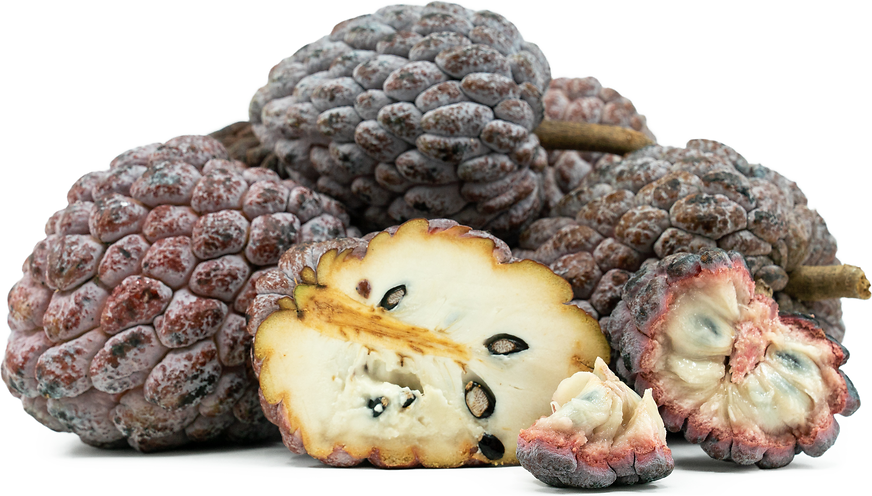


Purple Sugar Apples
Estimated Inventory, lb : 0
Description/Taste
Purple Sugar apples are a tropical fruit that grows on small trees. About the size of a baseball, they range from 5 to 13 centimeters in diameter and can weigh anywhere from 4 to 24 ounces. The knobby segments that cover the outside of Purple Sugar apples give them a scale-like appearance, loosely resembling a pinecone or a bunch of grapes. These segments have a dark burgundy tone and are covered in a thick, velvety rind that almost appears like a dusty residue is on top of them. Purple Sugar apples have a creamy white flesh with a pudding-like texture. Within this flesh lies anywhere from 20 to 38 shiny, dark brown seeds that are inedible. When fully ripe, Purple Sugar apples give off a sugary aroma. Their flavor is sweet, juicy, and tropical in nature with notes of vanilla and custard.
Seasons/Availability
The Purple Sugar apple is available mid-summer into fall.
Current Facts
Purple Sugar apples come from the botanical species Annona squamosa and are part of the Annonaceae family. They are the most widely grown of their species, which also includes similar-looking fruits like the Cherimoya and Atemoya. Sugar apples are also known as Annon or Sweetsop. They may appear reddish, which is why they are sometimes referred to as Red Sugar apples, or more specifically by their cultivar name, the Kampong Mauve. Sugar apples also come in green varieties and have been developed into different types, including the Thai Lessard, Cuban Seedless, and Brazilian Seedless. Along with the fruits themselves, the leaves, bark, roots, and seeds of Sugar apple trees have many medicinal uses. The seeds contain a yellow oil that can be used to remove lice from the scalp. The crushed leaves can be applied topically to cure ulcers and malignant sores, mixed with oil to treat scalp diseases, or applied to the nose during fainting spells. Purple Sugar trees are often used in parks and public spaces for shade or as ornamental trees.
Nutritional Value
Purple Sugar apples contain vitamin A, a nutrient that promotes healthy vision, immune function, and skin health. They also have various B vitamins that can help with energy metabolism, nerve function, breaking down fats, digestive health, nervous system function, and red blood cell production. Purple Sugar apples are a source of vitamin C, which helps with absorbing iron and collagen production. These fruits contain iron, manganese, and magnesium, nutrients that are important for transporting oxygen in the blood, bone formation, blood clotting, reducing inflammation, muscle and nerve function, blood pressure, and preventing anemia. Purple Sugar apples are a source of calcium, potassium, and phosphorus, which can help maintain strong bones and teeth, promote cardiovascular health, and potentially reduce the risk of stroke by lowering blood pressure. The juice that comes from Purple Sugar apples may be used to stop diarrhea. The unripe fruit and seeds may also have astringent properties that can be used in skincare.
Applications
Purple Sugar apples are mostly eaten fresh rather than cooked. To consume, the edible white pulp must be removed from the tough outer skin by scooping it out with a spoon. The pulp from Purple Sugar apples can be eaten on its own or used to make chilled desserts like ice cream, sherbert, and shakes. The fruits' unique flavor and consistency add a distinct texture to tropical drinks. Complimentary flavors include passion fruit, coconut, papaya, banana, citrus, ginger, berries, caramel, honey, dates, macadamia nuts, almonds, vanilla, and lemongrass. Purple Sugar apples should be stored in the refrigerator where they can be kept for up to 4 days.
Ethnic/Cultural Info
Sugar apples are popular throughout tropical Asia. They most likely reached those areas when they were brought to the Philippines by the Spaniards and to India by the Portuguese in 1590. From there, the fruits spread to Indonesia, China, Australia, Polynesia, and eventually Hawaii. Sir Hans Sloane's voyage to Jamaica from 1687 to 1689 may have been one of the first introductions of the Sugar apple to the West Indies. They were likely introduced to Brazil around 1626 by Conde de Miranda, giving the fruit its nickname 'fruta do conde'. Sugar apples have become an important commercial product in India, which is where the purple variety originated from. This purple version was then introduced to the Philippines in 1911, where Sugar apples remain a popular backyard fruit tree. In Cuba, Sugar apples rank alongside mangos as one of the country's most favored fruits. They have also become popular in subtropical areas of Florida, though they haven't been able to grow on a large scale in California.
Geography/History
Sugar apples are native to tropical South American countries including Argentina, Chile, Columbia, French Guiana, Guyana, Suriname, Uruguay, and Venezuela. From there, they quickly made their way to the West Indies and eventually Asia. They grow in tropical and subtropical climates and can be found in disturbed areas, roadsides, forests, grasslands, riverbanks, shrublands, plantations, orchards, and gardens. They are also produced commercially in many areas of the world. Sugar apples spread worldwide largely due to the Spanish and Portuguese colonists when they were making their way from South America to other parts of the world. Beyond their native regions, Sugar apples now grow in Bermuda, Mexico, the Bahamas, India, China, the Philippines, Australia, Hawaii, and Southern Florida. Purple Sugar apples can be found at grocery stores, farmers markets, gardens, and in the wild, especially in tropical areas.




